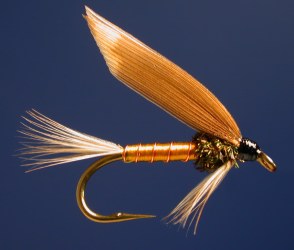Invicta Flies - Gold Dun
A soft gold good for imitating diving, egg-laying mayflies. A small shot about a foot above helps the pattern dive. When no shot is used, it can simulate emergers or small fry. Especially effective on overcast days, fished through deep pools.

Hook: Mustad 3906B, #10-16
Thread: Danville's Prewaxed 6/0, black
Tail: sandy dun or light ginger hackle fibers
Ribbing: fine copper wire
Body: rear 2/3 gold floss, front 1/3 peacock herl
Throat: sandy dun or light ginger hackle fibers
Wing: ringneck hen pheasant wing quill segments
Tying Instructions:
1) Secure the thread to the shank just behind the eye and wrap back to the bend. Unwind the thread so it lays flat and smooth. At the bend, tie in a bundle of sandy dun hackle fibers, preferably from the soft and webby portion near the base of the saddle feather. Lash the butt ends to the top of the shank, maintaining the smooth foundation up to about 1/3 the shank behind the eye. Clip any excess.
2) Lash the copper wire to the far side of the shank, wrapping smoothly back to the bend. The excess should extend out beyond the bend to be wound later. Wrap the thread forward again.
3) Tie in a four inch section of floss on the front 1/3 of the shank. Smooth the floss by stroking it gently away from the hook. Wrap this back to the bend in smooth touching turns, maintaining tension and realigning the strands by stroking again every other turn or so. Reverse and wrap back up the shank to the tying thread, tie off, and clip the excess.
4) Spiral the copper ribbing forward over the floss on open spirals. Tie off at the thread and clip the excess.
5) Form a dubbing loop with the tying thread, then tie in three or four peacock herls by their tips. Stroke the herls so the tiny fibers stand out from the stem, then hold these all together with the dubbing loop and twist to form a rope. A hackle pliers can assists in this. Bring the tying thread up to one hook eye width behind the eye. Wrap the peacock herl rope forward to the thread and tie off on the side (near or far side) of the shank. Clip the excess.
6) Clip a bundle of sandy dun hackle fibers similar to the tail and use the "pinch-loop" method to tie these in on the underside of the hook just in front of the peacock. The tips should almost reach the hook point. Use very fine scissors to clip the excess.
7) Clip a segment each from a matching pair of ringneck hen pheasant wing quills. The width should be about 3/4 the hook gap. Measure for length so the tips of the wings reach the middle of the tail then tie in on top of the shank. Using a pinch-loop method while pushing the wings down onto the shank helps tie these in uniformly. Clip the excess close and cover any exposed ends with the tying thread. Build up a small head with the thread and whip finish. Cement well.